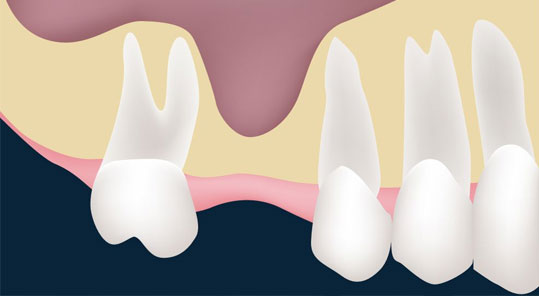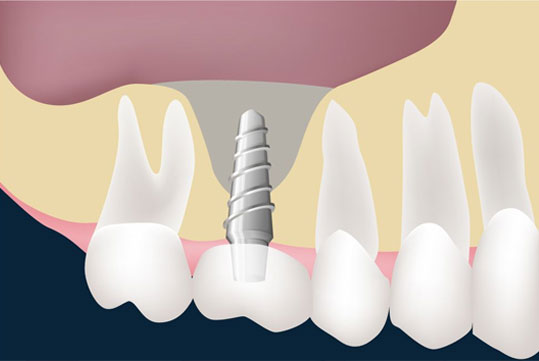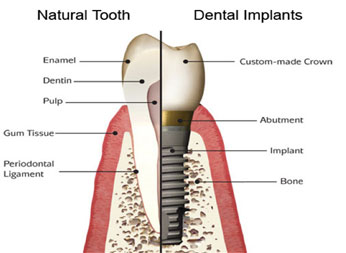single tooth dental implant - to replace missing tooth
Life time warranty for Implants provided by Nobel Biocare
A dental implant is a small titanium post that is inserted into the jawbone and provides a “root” for the placement of a restoration that looks, feels and functions similar to a natural tooth.
Implants are artificial replacements for natural tooth roots in the upper and lower jaws.
A These “anchors” resemble miniature screws and are usually made from titanium, which is highly compatible with bone.
They attach to the jawbone and gum tissue to become a stable base for replacement teeth, called crowns.
A single-tooth implant requires a series of procedures and time for the implant to successfully anchor, or osseointegrate, into the jawbone. This can take several months before the crown can be attached.
But, once the implant process is complete, you’ll enjoy a new smile for decades to come.
You may be a candidate if you are in good overall health, have healthy gums and adequate bone to support an implant. You must be committed to thorough oral hygiene and scheduling regular dental checkups.
why we need bone graft
jawbone recession

after bone graft

As soon as a tooth is lost, either from gum disease or an extraction, the supporting bone in the jaw begins to dissolve. This process is called resorption. The longer a tooth is missing, the greater the bone loss. Over time, resorption of the jawbone has a considerable effect on quality of life and on the possibility of replacing missing teeth.
A tooth should be replaced as soon as it is lost. This will retain your oral health by preventing bone loss, reducing movement of surrounding teeth and avoiding excess decay. Teeth provide more functions than just the ability to chew. They are necessary for the health of the gum and jaw tissues as well, and a prolonged absence of a tooth will severely limit the possibilities for restorations. Missing teeth may also affect your confidence and well-being.
Why bongraft needed after tooth extraction
Socket graft
A socket graft is performed after a tooth is extracted to prevent bone loss. Dr. Paul Li can perform this type of graft when immediate placement of an implant is not possible. During this procedure, Dr. Paul Li can pack the space left by the tooth with grafting material. Over the next three to six months, your body will absorb the material and replace it with new, healthy bone. Once this process is complete, Dr. Paul Li can place your implants.
screw or cement: which is best for attaching your implant crown?
If you’re in the initial planning stages for a dental implant, you may already be encountering a number of options to consider. One that may come up is how the visible crown will attach to the metal implant imbedded in the bone.
Generally speaking, implants are composed of two parts: a metal post most often made of titanium placed into the bone that serves as the “root” for the new tooth; and a visible, life-like crown made of dental porcelain that attaches to an abutment on the titanium post. The crown can be attached in one of two ways: either with a small screw through the biting surface of the crown into a receiving hole in the abutment or cemented to it. The major advantage of a screwed crown is that it allows for easy removal of the crown if needed. While the titanium post can often last a lifetime, porcelain crowns more often need repair or replacement since they receive the brunt of the biting forces in the mouth. A screw-attached crown is much easier to remove than a cemented one.
single implant benefits
Benefits

- Most natural-looking and functional solution for missing teeth
- Enhanced quality of life
- Integrity of the facial structures is preserved
- The smile is restored as close as possible to its natural state
- Long term health of adjacent teeth is not compromised
- Replacement teeth that look, feel and function like natural teeth
- Increased stability
- Improved health due to improved nutrition and proper digestion
- Renewed self-confidence
- Improved appearance
- Improved ability to taste foods
- Increased convenience of hygiene and maintenance